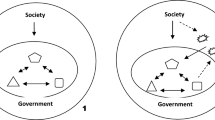Abstract
India has a rich tradition where good governance is highly valued. The theme of good governance is emphasized by a lineage of thought leaders from Kautilya in 230 BCE (प्रजासुखे सुखं राज्ञः प्रजानां च हिते हितम् । नात्मप्रियं हितं राज्ञः प्रजानां तु प्रियं हितम् ॥ अर्थशास्त्रः १.१९.४३ ॥ Chapter 19 titled राजप्रणिधिः duties of the king in Arthashastra of Kautilya. The happiness of the king is in the happiness of the people, his welfare is in the welfare of the people. The welfare of the king lies not in what he desires, but what his subjects desire) to Mahatma Gandhi [Mahatma Gandhi propounded the concept of “Su-raj” and according to him “good governance” has the following eight attributes, which link it to its citizens: (1) accountable, (2) transparent, (3) responsive, (4) equitable and inclusive, (5) effective and efficient, (6) follows the rule of law, (7) participatory and (8) consensus oriented] in recent times. However, achieving good governance in a country of size of India is hard. Good governance needs to address social, cultural, ethical and process dimensions. Governance not only needs to be good and efficient, but needs to human-centric. At times even well-intentioned and well-thought out processes of Government cause lot of trauma to common citizens. On the contrary doing away with safeguards is inviting disaster. To meet the objective of human-centric good governance, we have developed Tantra social information management framework. Tantra framework makes use of concepts from Zachman framework and unified foundational ontology. The framework itself is modeled as a social network (entity–entity network). Tantra framework interoperates with models such as balanced score card, theory of change and Bartels’ theory of separations. This paper describes the Tantra framework and how it can be applied to transform India’s electoral democracy.






Similar content being viewed by others
References
Aditya Bharadwaj KV (207) The struggle to get on the electoral rolls. The Hindu
Special Correspondent (2018) Voters list: HC notice to EC, BBMP on plea by Whitefield residents. Residents say officials are prejudiced. The Hindu
Zachman JA (2003) Zachman framework, a primer for enterprise engineering and manufacturing. http://www.zachmaninternational.com
Zachman JA (2007) The framework for enterprise architecture: background, description and utility. https://www.zachman.com/resources/ea-articles-reference/327-the-framework-for-enterprise-architecture-background-description-and-utility-by-john-a-zachman. Accessed Aug 2018
Santos PS Jr, Almeida JPA, Guizzardi G (2013) An ontology-based analysis and semantics for organizational structure modelling in the ARIS method. Inf Syst J 38:690–708
Kaplan R (2010) Conceptual foundations of the balanced scorecard, working paper
Weiss CH (1995) Nothing as practical as good theory: exploring theory-based evaluation for comprehensive community initiatives for children and families. In: Connel JP, Kubisch AC, Scorr LB (eds) New’ approaches to evaluating community initiatives, concepts, methods, and contexts. The Aspen Institute, Washington. ISBN 0-89843-167-O
Bartels R (1968) The general theory of marketing. The general of marketing, JSTOR
van Lier B. Blockchain, distributed ledgers and the Paxos protocol. http://www.finyear.com/BlockchaindistributedledgersandthePaxosprotocol_a35554.html
Lamport L (2001) Paxos made simple. ACM SIGACT News
Codd EF (1970) Relational model of data for large shared data banks. Commun ACM 13(6):377–387
Senko ME, Altaman EB, Astrahan MM, Fehder PL (1973) Data structures and accessing in data-base systems. IBM Syst J 12(1):30–93
Mealy GH (1967) Another look at data, AFIPS. In: Proceedings of the fall joint computer conference, pp 525–534. http://doi.ieeecomputersociety.org/10.1109/AFIPS.1967.112
Myers MD (1997) Qualitative research in information systems. MIS Q 21(2):241–242
Kavithakala C, Prabhu S (2015) Application of community detection algorithms in E-governance. J Basic Appl Eng Res JABER 2(13)
Anandan D. District magistrate, Gangtok. Challenges in managing electoral rolls. http://eci.nic.in/eci_main1/sharingportal/D.Anandan.sikkim.doc. Accessed Aug 2018
Scroll.in. (2016) Here is how election commission can ensure 100% accuracy in electoral rolls. https://scroll.in/article/808226/heres-how-the-election-commission-can-ensure-100-accuracy-in-urban-indias-voter-lists
Election Commission of India. FAQ on electoral rolls. http://eci.nic.in/eci_main1/Elecroll.aspx. Accessed Aug 2018
Chakrabarty B (2016) Ethics in Governance in India. Routledge Contemporary South Asia series. ISBN 9781317329091
Times of India (2017) 45% of Hyderabad electoral rolls revised using geo-tagging method
TM Forum Frameworx. https://www.tmforum.org/tm-forum-frameworx-2/. Accessed Aug 2018
BMC Software. How to embrace ITIL as an organization. https://youtu.be/jkrQWDOGfEk. Accessed Aug 2018
Acknowledgements
Authors acknowledge valuable feedback on this research received from Dr. S. G. Deshmukh, currently Director of ABV-Indian Institute of Information Technology and Management, Gwalior.
Author information
Authors and Affiliations
Corresponding author
Rights and permissions
About this article
Cite this article
Prabhu, S.M., Murthy, K.N.B. & Subramanyam, N. Transforming India’s electoral democracy using Tantra framework. CSIT 7, 261–276 (2019). https://doi.org/10.1007/s40012-019-00220-3
Received:
Accepted:
Published:
Issue Date:
DOI: https://doi.org/10.1007/s40012-019-00220-3




